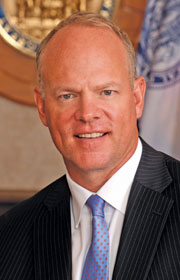Chances are if you’re reading this anywhere outside of Cheyenne, Casper or Laramie, you don’t know much about Wyoming. If you did, well, chances are you’d be in Cheyenne, Casper or Laramie. Or maybe skiing Jackson Hole, or marveling at the Grand Tetons.
Although evidence suggests pockets of Wyoming were inhabited for 8,000 years before the pyramids were built, it remains the least populated state in America. But lately it seems when folks, or companies, look into Wyoming, they like what they see, so much so that they show up and never leave.
That “best kept secret” status may soon change.
Some will tell you it’s the pro-business environment that draws strangers into the wide Wyoming spaces. A lot of states make the pro-business claim, but few put words into action like Wyoming. Others say it’s the neighborly people, the climate, or the quality of life notably different from other, less spacious places.
For companies like Microsoft and Wal-Mart, it’s all of the above.
Microsoft is just the latest big-name global corporation to homestead in Wyoming, unveiling in the spring the first $112 million phase of a state-of the-art data center just outside Cheyenne. There are hints that the recently constructed facility will be the first of multiple stages. In Wyoming, Microsoft has set down permanent roots.
About that business climate claim. According to the Tax Foundation’s annual State Business Tax Climate report, Wyoming has ranked first among the 50 states for most business-friendly tax code each of the last two years. One year ago 24/7 Wall St. published its annual list of best-run states and put Wyoming second in the nation. This year Wyoming placed fifth in the Pollina Corporate Top 10 Business Rankings, and is only two years removed from being named The Best Performing State Economy by The Atlantic.
All of this, and the state still manages to be the nation’s leading per-capita producer of renewable energy. That won’t soon change.
My friend Mark Willis, COO of Wyoming Business Council, has been in this business since about the time the aforementioned pyramids were finished. Mark came to Wyoming like so many others, never intending to stay. Mark interviewed with the state “on a lark.” Truth is, he’d never been to Wyoming and just wanted to see it. He wasn’t actually taking the interview seriously.
He, of course, wound up taking the job, but still assured himself that he’d stay “no more than three years, four max!”
That was a decade ago.

“Access to skilled labor was a key factor in Microsoft’s decision to locate, and grow.”
— Christian Belady, General Manager, Data Center Services, Microsoft
“Barring something catastrophic, I’ll never leave, and my kids, who once thought they were hard-core Texans, couldn’t be dragged away.”
Mark’s story is typical of so many Wyoming residents. He describes Wyoming as “one of the few adolescent states in America, possessing the resources and talent to grow up to be whatever it wants to be.”
Microsoft’s Location Checklist
Christian Belady, general manager of Data Center Services in Microsoft’s Global Foundation Services Group, tells Site Selection that “access to skilled labor was a key factor in Microsoft’s decision to locate, and grow, in Wyoming. When choosing data center sites, Microsoft evaluates over 35 weighted criteria, including close proximity to customers, an ample and reliable power source and fiber optic networks, availability of land, a large pool of skilled labor, and affordable energy rates to determine the long-term viability of each site.”
Mr. Belady emphasized that the decision to build a data center in Wyoming is a long-term commitment.
“The grant helped provide the infrastructure needed for our datacenter in Cheyenne,” he says. “This new facility provides Wyoming and Microsoft with a win-win opportunity that will provide quick, reliable access to Microsoft online services for regional users. It also creates new full time jobs at this data center facility and up to 200 construction jobs, while helping Wyoming to meet its long-term goals of recruiting large technology-related business opportunities that diversify and strengthen the state’s business environment.”
In her excellent book Fate of the States, Meredith Whitney predicts Wyoming, and other “Central Corridor States,” will lead an American economic revival, particularly since they’re not burdened with the massive unfunded pension liabilities and exorbitant corporate tax rates often imposed to pay for them. These factors help explain why Wyoming is one of only seven U.S. states which still maintain a AAA credit rating.
That, too, appears here to stay.
Q&A with Governor Matt Mead
Governors tend to be the strongest advocates for the states they serve, and Wyoming’s Matt Mead is no different. In an interview with Site Selection Governor Mead’s enthusiasm and obvious belief in his state’s economic promise are palpable.
Site Selection: Wyoming’s economy is out-performing most of the US. What’s the secret?
Gov. Mead: It is not a secret, and we are eager to talk about Wyoming’s good economy. Our tax structure, our fiscally conservative nature, and the way we run government regularly draw high marks in rankings of the states. We have more people and more businesses moving to Wyoming — our vibrant communities and great outdoor recreation opportunities are among the attractions. I believe we have the right mix of regulatory certainty and freedom for companies.
Wyoming has a growing reputation in the technology industry as a place that is well suited for data centers. Our climate reduces cooling costs for data centers, we have exceptionally low power costs, and we have the necessary fiber optics. Our transportation connections, including major east-west and north-south highways, are features attractive to many types of businesses.

Gov. Matt Mead
Lastly, we remain an energy state. Wyoming exports more BTUs to the rest of the country than any other state. We provide low-cost power — lots of it — to the nation and the nation’s economy. This benefits businesses here as well because electricity rates in Wyoming are among the lowest in the United States. Wyoming is an energy leader, and this will not change — we have abundant resources.
SS: What’s the biggest misconception about doing business in Wyoming?
MM: That modern businesses cannot succeed here. They can and do. We have a leading online English language education company based here and the company’s students are often in Asia. Technology is the bridge. We have start-ups filling niches in the data center world, and we have giants like Microsoft.
It is true we are the least populated state, and it is true we are a rural state with wide open spaces and small towns. However, we view these characteristics as assets. Our quality of life is second to none. This means that the business owners who have chosen Wyoming are here because of the lifestyle, great schools, cost of living, and natural beauty. They not only want to work in our state, they want to live in our state.
We are highly connected to broadband. The nation’s fiber backbone traverses our state along Interstate 80. In the next two months every county in our state will have Ethernet connections in their towns and cities. This creates opportunities for new businesses to grow, and it gives us unlimited access to tele-education, tele-health and tele-commuting.
Being a rural state is part of our heritage and our future. I believe this is attractive (think, for example, no rush hours), and continually upgrading our technology infrastructure, which we are doing, is a boon for further economic growth.
SS: What are Wyoming’s greatest attributes for potential investors?
MM: Wyoming is part of the Mountain West region, which a recent Forbes’ report identified as the area in the United States best positioned for growth. Investors are looking ahead at areas like ours because the opportunity here is extraordinary.
Wyoming’s leading industry is energy, followed by tourism and agriculture. Technology-related business is on the rise. With energy, while we supply raw BTUs for the country, we also seek to add value to these resources right here in Wyoming. New technologies and markets are emerging and investors are taking note. In-situ gasification is one example of a process that could add value to our abundant coal resources. Partnering natural gas with wind power generation to provide a consistent source of power is another example. We are not settling for the way it has always been done, we support innovation and entrepreneurship.
The University of Wyoming, our only public university, plays a large role in partnering with industry. The relatively new Energy Innovation Center at the UW School of Energy Resources underscores this partnership. The mission of the Center is to position Wyoming as a global leader in energy education, research and outreach.
SS: How will the state grow its labor force to meet the needs of new, specialized industries?
MM: The University of Wyoming and our community colleges already have strong relationships with industry to meet specific needs. Our colleges have created customizable programs for many niche markets, including the wind power industry.
“Wyoming is one of the few adolescent states in America, possessing the resources and talent to grow up to be whatever it wants to be.”
— Mark Willis, COO of Wyoming Business Council
In addition, the Wyoming Department of Workforce Services offers a variety of training grants with respect to new employees as well as existing employees for all industries in the state. This was a key for Microsoft to know it would have employees at its new data center. We are attuned to workforce needs and responsive to them — not only now but planning ahead too.
SS: Can Wyoming’s investment incentives compete with other states? How?
MM: We certainly do offer incentives such as our Business Ready Communities grant and loan program, which help fund infrastructure for Wyoming’s cities and towns to become more business ready. This program benefits the community by giving them a marketable asset for business recruitment while also lowering the up-front costs for a company to expand or come in and open up shop.
In addition, we have a manufacturing sales tax abatement, data center sales tax abatement, cost reduction grants, and workforce training grants. My office also has resources available to recruit high tech companies. These are all parts of Wyoming’s incentive package.
But, the bottom line here is that companies in Wyoming see a much lower cost of doing business and experience lower regulatory risk over the long term. We have a tax structure rated as the most business friendly in the country, a strong economy, and a stable regulatory environment. These make us competitive in economic development. Our incentives play a role in that process as well.
Our state is competitive. The proof is in decisions such as Microsoft’s choice of Wyoming over many other states that were also vying for that company. We know we are competing regionally, nationally and internationally. Our mix of incentives ultimately attracted Microsoft in what was a highly competitive situation. Further, we then went on to create a second public-private partnership with Microsoft to test a system for powering data centers with waste water. This was largely due to our established ability to respond to the company’s needs.

